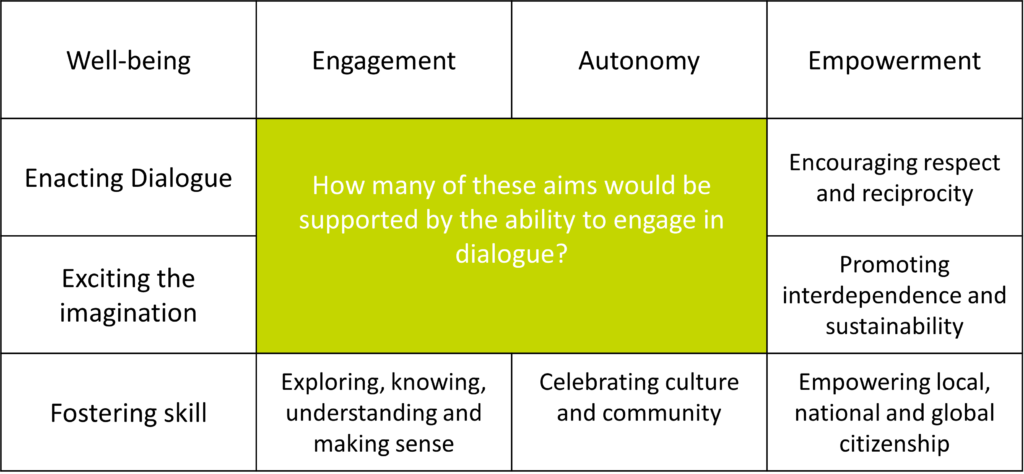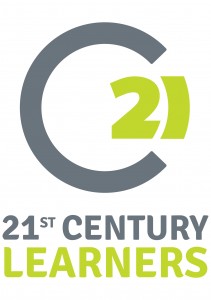The hopefulness of teaching for dialogue

I often argue the case for dialogue as a medium through which young people can learn about curriculum subjects more deeply (see my series ‘A Teacher’s Guide to Dialogic Pedagogy‘, for example). In this post I want to make an argument for dialogue as an endpoint of education. I’ll argue that it offers us a better way to be, that it enables a person to gain a richer understanding of him or herself, of other people, and of the world, and that it offers hope for the future. Let’s start with some everyday experiences.
Making the (dialogic) switch
When I go for a run or a walk on the lanes around my home, I’m prone to curse the drivers who force me into the edge: “Too fast!”; “Why don’t they stay on the main roads?” When I drive on the lanes around my home, I’m prone to curse the runners and walkers who force me to slow to a crawl: “This is a road – stick to the footpaths!” Having experienced both perspectives, I hope I’m becoming better able to switch between them: when I’m running I can imagine how the driver might see things and tuck into the edge, when I’m driving I’m more likely to be patient and careful (and stick to the main roads). Perhaps, in a limited way, I am a better person for having experienced both sides.
Making that switch is not so easy when one doesn’t have first-hand experience of both perspectives. My wife’s family have a very different social and cultural background to my own. Sometimes these two worlds come into conflict – when we are making decisions about the children’s upbringing, for example. I went to my local comprehensive school and did well, why wouldn’t it be the same for my boys? Grammar schools? Private schools? Faith schools? No! These represent misguided courses of action for those who don’t really ‘get’ the comprehensive ideal.
It’s only when the competition stops (my way’s better than your way!) and we each begin to immerse ourselves in the other’s world, taking a genuine interest in the experiences that shaped us and our parents, that we gain another perspective – another window onto the world, if you like. When my wife looks at me and tells me why she values faith schools, I can see ‘behind her’ the landscape that gave rise to that position, and I can even imagine myself standing where she is looking back at the landscape of my own experience and recognise that it is limited – just one point of view in countless possibilities. In a way, I have been able to make the switch and experience both sides – my awareness is expanded and I am better for it.
But this kind of ‘switching’ of perspective takes time, effort and genuine curiosity – desire and care to understand the other view. Is this realistic in encounters with others we don’t know so well, and whose views seem so different from our own? I think it is, but it’s hard – harder than we might think. So why make the effort?
Understanding our stories
One more anecdote. My neighbour’s trees keep the light off my garden. It’s only when I stand in his garden – on his side of the fence – that I can see them as a beautiful backdrop and as protectors of his privacy. It doesn’t stop me wishing they were smaller, but I understand their value to him; perhaps if I invite him to stand in my garden, a compromise will be reached.
We’re all divided from our neighbours by metaphorical fences – barriers to our understanding of one another. As long as we stand only in our own garden looking out, we will be surrounded by alien perspectives, by people who just don’t seem to get it, and we will be forever bounded by our own experience. That’s not a great place to be – it’s not a great way to be. In the end we’ll build those fences higher, retreat into our isolated selves or our likeminded tribes, and take up arms against the world outside.
In his book A Swim in a Pond in the Rain, George Saunders writes about how stories change our minds as they allow us to ‘step out of our own (limited) consciousness and into another one (or two, or three)’. He tells us how stories have allowed him to feel an increased confidence in his ability to imagine the experiences of other people and to accept them as valid. In a world in which so many of us so often fail to understand each other, this sounds like a great gift.
I think we all need to learn to listen to stories – to turn to them with an open heart and an open mind. Not just fictional, written stories, but also the spoken stories of our neighbours. As we listen, we need to use our imagination to visit the other perspective – to stand in that other landscape. We need to show care and curiosity as we seek to understand before making judgements.
We need to learn to tell our own stories too – to share our opinions and ideas, and also to be willing to examine the experiences that gave rise to them and to acknowledge our uncertainties and our fallibility. We need a genuine concern to make ourselves understood by the other, choosing our words with him or her in mind. Then we can hold our different stories together and explore (with a critical yet creative mind) the space of difference between them so that our awareness is expanded and, perhaps, our minds are changed. We need to learn to ‘be in dialogue’ with the world around us.
Teaching for dialogue
By teaching young people how to engage in dialogue we are offering them much more than enhanced academic performance – we are offering them a better way to be in the world. This is a process that will develop virtues such as care, collaborativeness, criticality, creativity, reasonableness, tolerance, patience, open-mindedness, open-heartedness, humility, communicativeness, attentiveness and more. It will also engender feelings of concern, trust, respect, appreciation, affection and hope; hope of the possibility of new insights, new understandings, richer relationships and a better future.
Developing such virtues requires conscious effort and practice – a process that often begins by negotiating and following ‘ground rules’ for dialogue in the classroom (we listen attentively, we offer challenge respectfully, we look for connections, we build on the ideas of others etc.). Over time, and together with those around us, we move from unthinking obedience to such rules to a conscious awareness of their value and then to an ability to deliberately apply them; ultimately they become part of our character. If schools offer young people the chance to regularly engage in dialogue about things of genuine interest (to their academic learning and to their wider lives), and to consciously develop the skills and dispositions (and ultimately virtues) needed for dialogue, then the rewards will be great.
In the Cambridge Primary Review (CPR), Professor Robin Alexander suggests 12 aims of primary education:
Enacting dialogue is presented as an aim in itself here, justifed (in the CPR) in terms of the role of dialogue in the acquisition of knowledge and understanding. The other aims remind us that the outcomes of a good education extend well beyond the academic curriculum. I would argue that our chances of achieving many, if not all, of these aims can be enhanced by young people learning the skills of dialogue. Take the aim of empowering young people to be local, national and global citizens, for example.
Generation Global (GG) is an organisation that describes itself as a ‘global citizenship education programme for young people of ages 13 to 17-years’. Drawing on a great deal of expertise in the field of dialogue and supported by resources such as the wonderful classroom guide Essentials of Dialogue, GG trains teachers and supports students around the world to engage in on-line dialogue on subjects such as the United Nations Sustainable Development Goals, The Rights of Girls and Women and Identity and Belonging. Here are some thoughts about the value of the programme from teachers and pupils at Helles School in Plymouth in the UK:
I facilitate dialogues for GG and it’s a role that gives me hope. I see so many young people showing concern to understand each other and to explore topics that matter to them, to their communities and to their futures. Supporting them to learn the skills of dialogue can only enahnce their capacity to work together to make a difference, and I feel sure that many of them will go on to do so.
There’s that theme of hope again. And don’t we just need it at the moment! A glance at world affairs brings me back to the idea of people who ‘build those fences higher, retreat into their isolated selves or likeminded tribes, and take up arms against the world outside.’ How might a generation of people with a more dialogic outlook – a willingness to spend some time in each other’s gardens or landscapes – influence some of these world events for the better?

Dialogue in schools is more than a tool for academic development; it is an outcome that has enormous intrinsic value. It offers young people a way of better understanding themselves and those around them. It offers them a way of becoming more connected with the world – having a feeling of being in it rather than being a helpless observer of it. It offers hope.
Bibliography
Alexander, R. (ed) (2010) Children, their World, their Education: Final report and recommendations of the Cambridge Primary Review. Abingdon: Routledge
Burbules, N. C. (1993) Dialogue in Teaching: Theory and Practice. New York: Teachers College Press
Saunders, G. (2021) A Swim in a Pond in the Rain. London: Bloomsbury
Wegerif, R. (2013) Dialogic: Education for the Internet Age. Abingdon: Routledge
Acknowledgements
I am grateful to Generation Global (part of the Tony Blair Institute) for the opportunity to facilitate dialogues between young people, and for all that I have learned from my colleagues. You can visit their website here.
All of my writing and thinking about dialogue is influenced by Professor Rupert Wegerif
This blog has, in part, emerged from my recent converstations with Roger Sutcliffe of Dialogue Works as we have striven to craft a new course for teachers on dialogue. It’s been a great pleasure and a privilege, Roger!



